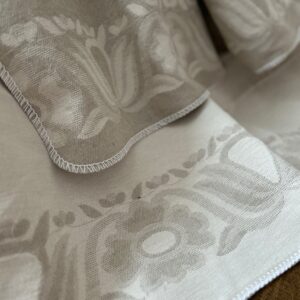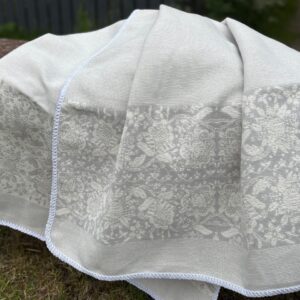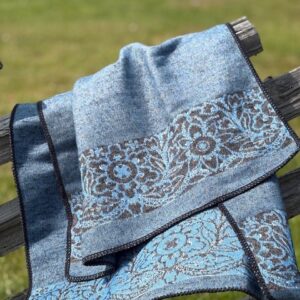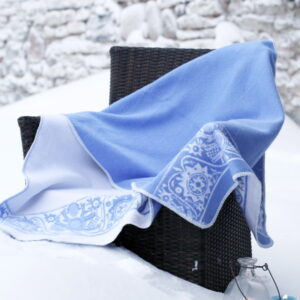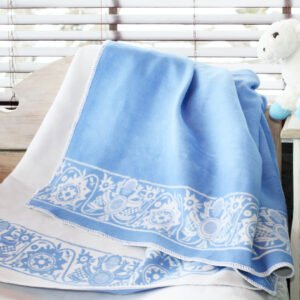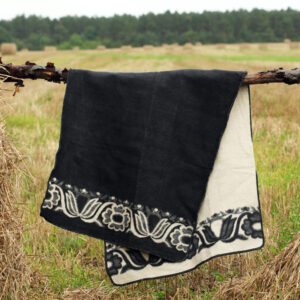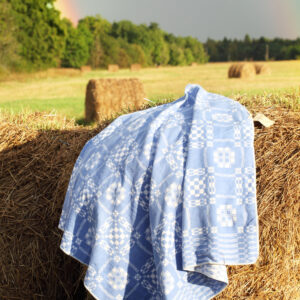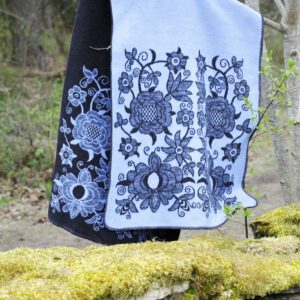+ Näita rohkem
-
70x200, 100% cotton
-
105 x1 80
-
140 x 200
-
140x200, 100% cotton
-
70x200, 100% cotton
-
Dimensions 70 x 180 cm 100% cotton In North Estonia, flower pattern was dominant in the first half of the 19th century.It seems strange how colourful, manifold and rich is the art of embroidery in the small territory of Estonia. A good example is the Jõelähtme sleeve pattern used on North Estonian scarf - its pattern is peculiar and diverse.Wrap was being worn lengthways on one’s back; the corners were secured on the breast with a brooch or yarn. The tradition of wearing wraps remained until the beginning of the 19th century.
-
Dimensions 140 x 200 cm 100% cotton In North Estonia, flower pattern was dominant in the first half of the 19th century.It seems strange how colourful, manifold and rich is the art of embroidery in the small territory of Estonia. A good example is the Jõelähtme sleeve pattern used on North Estonian scarf - its pattern is peculiar and diverse.Wrap was being worn lengthways on one’s back; the corners were secured on the breast with a brooch or yarn. The tradition of wearing wraps remained until the beginning of the 19th century.
-
Dimensions 75 x 180 cm 70% cotton, 30% flax On the North Estonian scarf, Maarja sleeve pattern, that is notable for its peculiarity, is used. The yarn that was used was woollen, cotton or silk. Often black and combination of two or three colours was used. The black patterns on the sleeves were silk for the rich and sown for the poor people.Wrap was being worn lengthways on one’s back; the corners were secured on the breast with a brooch or yarn. The tradition of wearing wraps remained until the beginning of the 19th century.
-
Dimensions 145 x 200 cm 70% cotton, 30% flax On the North Estonian scarf, Maarja sleeve pattern, that is notable for its peculiarity, is used. The yarn that was used was woollen, cotton or silk. Often black and combination of two or three colours was used. The black patterns on the sleeves were silk for the rich and sown for the poor people.Wrap was being worn lengthways on one’s back; the corners were secured on the breast with a brooch or yarn. The tradition of wearing wraps remained until the beginning of the 19th century.
-
Dimensions 140 x 170 cm 100% cotton In North Estonia, the tradition of wearing wraps remained until the beginning of the 19th century. Wrap was being worn lengthways on one’s back; the corners were secured on the breast with a brooch or yarn.Woven plaids were commonly tartan and in certain colours; white and blue e.g. Blue symbolized the sky and thinking. Special technique was also used to make plaid in checked pattern, depending on the fabric and treading.
-
North Estonian scarf Lääne-Viru County/ Rakvere shawl 70x200 Rakvere shawl was created in honour of Estonian Mendance Festival 2015. May this shawl with rich flower motifs adorn all the ladies as the men of the dance festival please their eye and soul. We are able to preserve our culture through patterns, folk dance and by sticking together! The creation of Rakvere shawl was also greatly influenced by Heimtali Museum of Local History, because that is where I got the idea as I was admiring some doilies with native flower patterns. In fact, doilies are the reason why Rakvere shawl of Ellu sallid is so beautiful. The shawl is distinguishable by its big flower motifs and feminine because of the handicraft of our foremothers from Lääne-Viru. Doilies with rich flower patterns from that area were recognised and admired already in the first half of 19th century. Now the rich flower embroidery from Lääne-Viru County adorns the Rakvere shawl of Ellu sallid. To follow the tradition of that time period, two colours are used in waving the Rakvere shawl. Well-to-do ladies used silky yarn in their embroidery, but wool was always esteemed as well. Colour-wise, women from Lääne-Viru preferred sky-blue shades because firstly, they had a bold style and secondly, these colours made their clothing even more distinct. All these clear colours from the sky, as well as ladies’ joy to create radiant beauty around them, are reflected in the Rakvere shawl. The tradition of wearing scarves and shawls has a long history in Estonia. Shawls were considered to be the most valued piece of a folk costume and it was mainly a part of festive clothing. When it was cold outside, shawl would keep you warm while going to church or visiting someone. In warmer weather, it would add festivity to your outfit, being carried on your arm. More skilfulness was needed for making a shawl than for any other piece of clothing. Therefore shawls, as well as the knowledge and skills of making them, were well-kept and passed on to next generations. In North Estonia, shawls were worn lengthways on one’s back; the corners were secured on the chest with a brooch or some yarn. Let’s follow the tradition of our foremothers by throwing on some blossoms and pleasing the soul and eye of the ones nearby!
-
North Estonian scarf Lääne-Viru County/ Rakvere shawl 70x200 Rakvere shawl was created in honour of Estonian Mendance Festival 2015. May this shawl with rich flower motifs adorn all the ladies as the men of the dance festival please their eye and soul. We are able to preserve our culture through patterns, folk dance and by sticking together! The creation of Rakvere shawl was also greatly influenced by Heimtali Museum of Local History, because that is where I got the idea as I was admiring some doilies with native flower patterns. In fact, doilies are the reason why Rakvere shawl of Ellu sallid is so beautiful. The shawl is distinguishable by its big flower motifs and feminine because of the handicraft of our foremothers from Lääne-Viru. Doilies with rich flower patterns from that area were recognised and admired already in the first half of 19th century. Now the rich flower embroidery from Lääne-Viru County adorns the Rakvere shawl of Ellu sallid. To follow the tradition of that time period, two colours are used in waving the Rakvere shawl. Well-to-do ladies used silky yarn in their embroidery, but wool was always esteemed as well. Colour-wise, women from Lääne-Viru preferred sky-blue shades because firstly, they had a bold style and secondly, these colours made their clothing even more distinct. All these clear colours from the sky, as well as ladies’ joy to create radiant beauty around them, are reflected in the Rakvere shawl. The tradition of wearing scarves and shawls has a long history in Estonia. Shawls were considered to be the most valued piece of a folk costume and it was mainly a part of festive clothing. When it was cold outside, shawl would keep you warm while going to church or visiting someone. In warmer weather, it would add festivity to your outfit, being carried on your arm. More skilfulness was needed for making a shawl than for any other piece of clothing. Therefore shawls, as well as the knowledge and skills of making them, were well-kept and passed on to next generations. In North Estonia, shawls were worn lengthways on one’s back; the corners were secured on the chest with a brooch or some yarn. Let’s follow the tradition of our foremothers by throwing on some blossoms and pleasing the soul and eye of the ones nearby!




